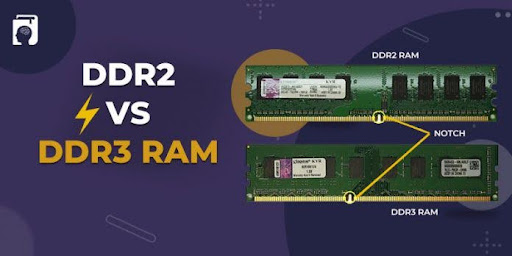How do DDR2 vs DDR3 fare against each other? Well, let’s find out.
How old were you when your father bought you your 1st computer in 2004? How old were you when you bought a laptop or a desktop for yourself in 2012?
Working on two different generations of computers, you must have realized the difference in their execution of tasks, transferring rate of data, and the amount of information you were able to store in them. Ever wondered why your 2012 purchased computer functioned better than the 2004 one?
This was because of the difference in the installed RAMs (Random Access Memory) in both generations. DDR2 RAM was used in computers until 2007-08. Post that DDR3 RAM came in as an advanced and more efficient form of RAM for computers. They were better in every aspect compared to their predecessors.
Difference Between DDR2 and DDR3 RAM
In this article, we brief you on DDR2 and DDR3, along with their features, advantages, and disadvantages. We even elaborate on the difference between DDR2 and DDR3. By the end of this, you will have a better understanding of their capabilities and performance.
What is DDR2 RAM?
What is DDR2 RAM? That’s a common query. Well, DDR2 or “Double Data Rate 2” was the 2nd generation of RAM (Random Access Memory). It was a successor to DDR, the 1st generation of RAMs. As technology evolved, more powerful and faster desktops and laptops hit the market. They needed faster RAMS and a large storage capacity. To keep up with the trend, the 2nd generation of DDR RAMS made its way into the market.
DDR2 exceeds DDR in about every segment. The data transfer rates were upgraded and set at a range of 400-1066MT/s. The voltage at which DDR2 consumes power is 1.8V. Lower voltage ensures less power consumption, which ultimately lowers the burden on the CPU. The DDR2 RAM sticks usually come with a standard 2GB storage but can be exceeded up to 4GB the most.
DDR2 is different in terms of design and structure from DDR. The modified structure allows the DDR2 more bandwidth, where more data is expected to flow through. The drawback, however, is that it is not compatible with DDR-installed computers as both DDRs are different in design.
Features of DDR2
Following are some salient features of DDR2, which will help you understand the difference between DDR2 and DDR3 RAM.
- DDR2 has a voltage of 1.8V, better than its predecessor.
- It features a pin interface of 240 pins.
- Its design allows a greater bandwidth to store information.
- DDR2 can attain a clock speed ranging from 400 to 1066Mhz.
- Being an SDRAM, it operates faster than internal memory.
Advantages of DDR2
Let’s have a brief look at some pros of DDR2.
- Low power consumption
- Higher Data transfer rates than DDR.
- A better design allows for storing more information.
- Can calibrate its devices.
- Can be attached to external devices and remotely accessed.
Disadvantages of DDR2
When it’s about DDR3 vs DDR2, knowing the disadvantages of DDR2 is vital.
- It is outdated and only used in computers manufactured before 2008.
- The power consumption rate is higher than its successor, draining out the battery quickly.
- The heat generated is high, which reduces the CPU life.
- It can only store a limited amount of data, which is not feasible in today’s digital world.
What is DDR3 RAM?
By now, you know what is DDR2. So, let’s shift our focus to DDR3 to know the difference between DDR3 and DDR2. DDR3 is an abbreviation for “Double Data Rate Type 3.” It is a form of SDRAM used by the computer system to increase memory and speed up data transfer. With technology advancing at a jet speed, data storage has also progressed at about the same pace. To store large amounts of data and transfer them at a faster pace, newer, improved versions of DDRs have been regularly introduced at intervals.
DIMM (Dual In-line Memory Module) and SO-DIMM (small outline-DIMM) memory modules are the two types of memory modules available on the market. The former is utilized in desktop computers and the latter in laptops. DDR3 RAM is architecturally and structurally similar to its predecessor, DDR2 RAM. DDR3 RAM consumes 30% less energy than the earlier DDRs. DDR3 enhances the data transfer rate as well.
It also includes an improved level known as DDR3L, which has dual voltages of 1.5V and 1.35V. The higher voltage DDR3 is utilized in PCs and business servers, whereas the lower voltage DDR3 is used in smartphones, laptops, and tiny devices. The data transmission speed of a DDR3 RAM module is 64 times faster than the memory clock speed for modules of memory. That’s a prime difference between DDR2 RAM vs DDR3.
Features of DDR3
Let’s take a tour through the features of DDR3
- It can reset devices.
- The DDR3 device pinout has been improved.
- It has a unique ODT that enhances write signaling.
- The data transfer rate is high, ranging from 800 to 1600 MT/s(mega transfers per second).
- It has a 1.5-volt voltage.
- It has the standard lower signaling.
Advantages of DDR3
Done with features? Now have a look at what makes DDR3 a better option.
- DDR3 has a better memory storage bandwidth.
- It comes with an upgraded version, DDR3L, which has dual voltage.
- The data transfer speed is higher than all its predecessors.
- It has a good level of stability and runs smoothly.
- It fares better on the power efficiency front compared to its forerunners.
Disadvantages of DDR3
The following points might make you rethink adopting DDR3. Also, you’ll get a clearer picture of DDR2 vs DDR3.
- It drains electricity quicker when compared to its successor.
- Because of the high power usage, it tends to heat up quickly.
- It is more expensive.
- The CAS latency is much higher than that of other DDRs.
- A new motherboard must be installed when upgrading, which is rather costly.
DDR3 vs DDR2: Key Points to Remember
When all is said and done, it’s time to discuss what is the difference between DDR2 and DDR3. The DDR2 vs DDR3 difference can be summarized as follows.
- DDR2 has a power consumption voltage of 1.8V. For DDR3, on the other hand, it is 1.5V.
- DDR2 has a buffer prefetch of 4n while DDR3 has an 8n buffer prefetch.
- DDR2 attains a channel bandwidth of 3.20-8.50 GB/s while DDR3 has a channel bandwidth of 6.40-17.0 GB/s.
- DDR2 produces more heat than DDR3.
- DDR2 has a bus clock range of 200-533 Mhz while DDR3 has a bus clock range of 400-1066 Mhz.
- DDR2 consumes more power than DDR3.
DDR2 vs DDR3: Head to Head Comparison
Let’s summarise the DDR2 and DDR3 differences for a quick reference.
| Parameters | DDR2 | DDR3 |
| Voltage | 1.8V | 1.5V |
| Buffer prefetch | Buffer prefetch of 4n | Buffer prefetch of 8n |
| Channel Bandwidth | 3.20-8.50GB/s | 6.40-17.0GB/s |
| Heat | Higher | Lower |
| Bus clock range | 200-533Mhz | 400-1066 Mhz |
| Power consumption | Higher | Lower |
Conclusion
We are sure you must be clear in mind by now about the reason behind your 2012 purchased computer performing better than the 2004 purchased computer. When it comes to DDR2 vs DDR3, both were an updated, better version of their former ones. With technology transforming rapidly, DDRs are also coming with new generation types at regular intervals.
People are also reading:




